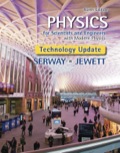
Review. A 670-kg meteoroid happens to be composed of aluminum. When it is far from the Earth, its temperature is –15.0°C and it moves at 14.0 km/s relative to the planet. As it crashes into the Earth, assume the internal energy transformed from the mechanical energy of the meteoroid-Earth system is shared equally between the meteoroid and the Earth and all the material of the meteoroid rises momentarily to the same final temperature. Find this temperature. Assume the specific heat of liquid and of gaseous aluminum is 1 170 J/kg · °C.
The value of the final temperature.
Answer to Problem 20.73AP
The value of the final temperature is
Explanation of Solution
Given info: The mass of the meteorite is
Write the expression for the gravitational potential enegy.
Here,
Write the expression for the kinetic enegy.
Here,
Write the expression for the loss of mechanical energy of the meteorite.
Substitute
Substitute
Thus, the loss of mechanical energy is
The value of the internal energy is half of the loss of mechanical energy.
Write the expression for the internal energy.
Substitute
Thus, the internal energy is
Write the expression for the energy required to increase the temperature.
Here,
Write the expression for the rate of energy required during a phase change.
Here,
For the energy required to raise the temperature to a melting point.
Substitute
Thus, the energy required to raise the temperature to a melting point is
For the energy required to melt the meteorite.
Substitute
Thus, the energy required to melt the meteorite is
For the energy required to raise the temperature to a boiling point.
Substitute
Thus, the energy required to raise the temperature to a boiling point is
For the energy required to boil the meteorite.
Substitute
Thus, the energy required to boil the meteorite is
Write the expression for the internal energy change for the meteorite.
Substitute
Conclusion:
Therefore, the value of the final temperature is
Want to see more full solutions like this?
Chapter 20 Solutions
EBK PHYSICS FOR SCIENTISTS AND ENGINEER
 Physics for Scientists and Engineers, Technology ...PhysicsISBN:9781305116399Author:Raymond A. Serway, John W. JewettPublisher:Cengage Learning
Physics for Scientists and Engineers, Technology ...PhysicsISBN:9781305116399Author:Raymond A. Serway, John W. JewettPublisher:Cengage Learning Principles of Physics: A Calculus-Based TextPhysicsISBN:9781133104261Author:Raymond A. Serway, John W. JewettPublisher:Cengage Learning
Principles of Physics: A Calculus-Based TextPhysicsISBN:9781133104261Author:Raymond A. Serway, John W. JewettPublisher:Cengage Learning Physics for Scientists and Engineers: Foundations...PhysicsISBN:9781133939146Author:Katz, Debora M.Publisher:Cengage Learning
Physics for Scientists and Engineers: Foundations...PhysicsISBN:9781133939146Author:Katz, Debora M.Publisher:Cengage Learning
 College PhysicsPhysicsISBN:9781938168000Author:Paul Peter Urone, Roger HinrichsPublisher:OpenStax College
College PhysicsPhysicsISBN:9781938168000Author:Paul Peter Urone, Roger HinrichsPublisher:OpenStax College College PhysicsPhysicsISBN:9781305952300Author:Raymond A. Serway, Chris VuillePublisher:Cengage Learning
College PhysicsPhysicsISBN:9781305952300Author:Raymond A. Serway, Chris VuillePublisher:Cengage Learning





